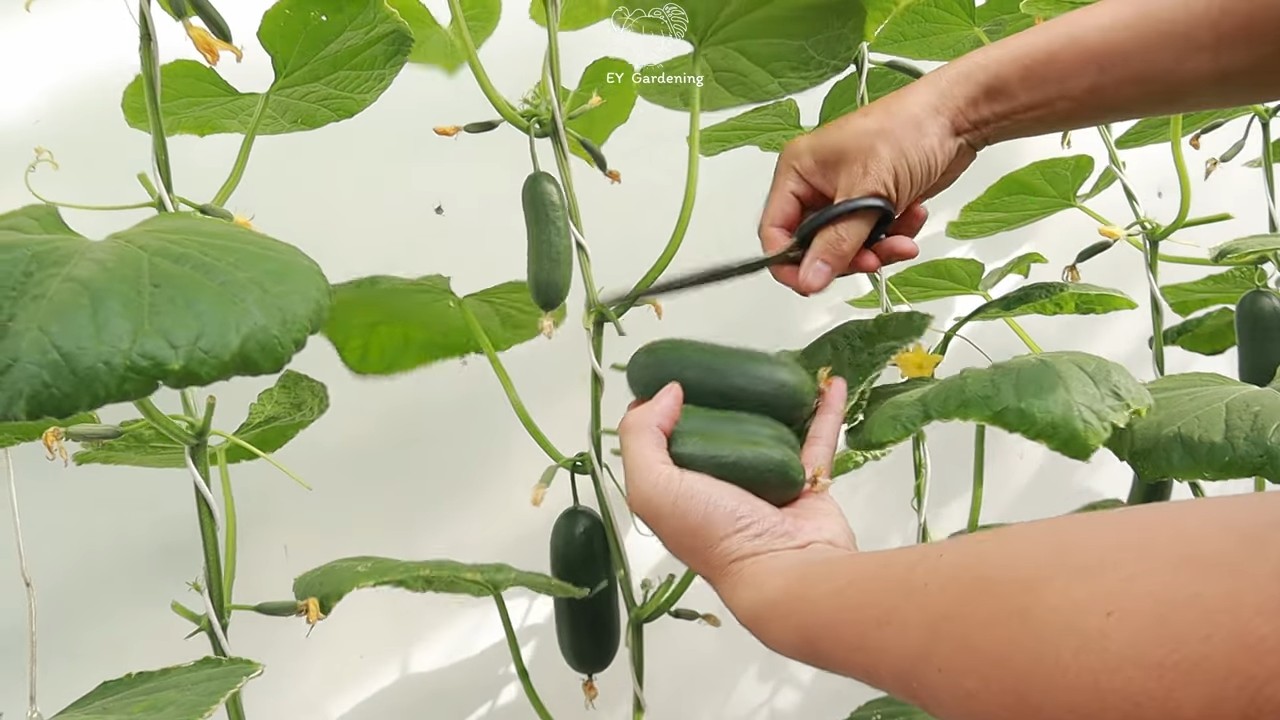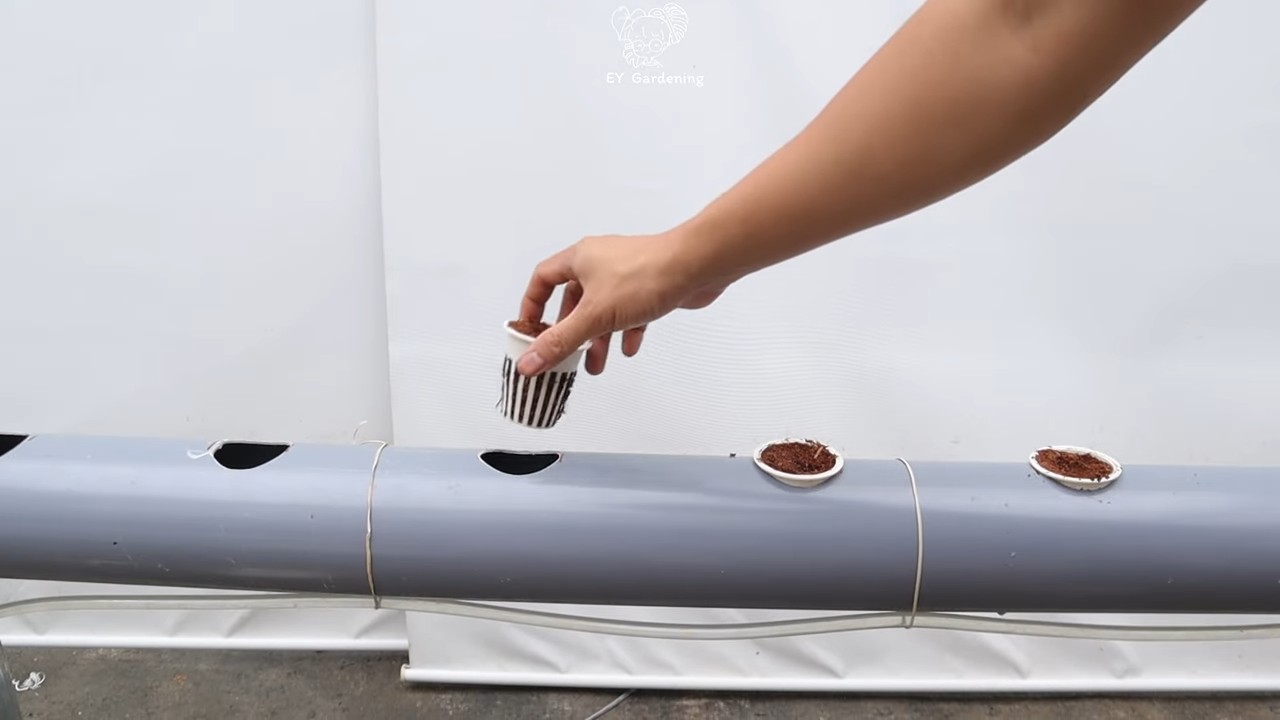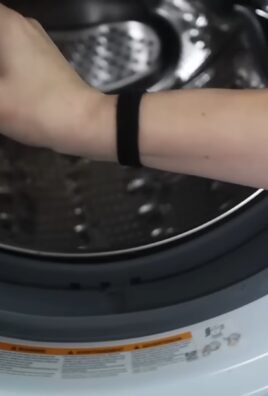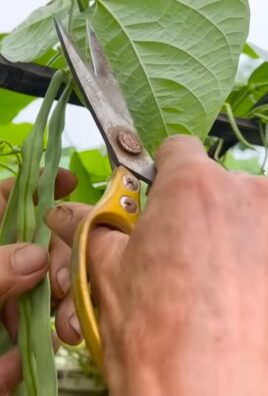Growing cucumbers in water might sound like something out of a futuristic sci-fi film, but trust me, it’s a surprisingly simple and rewarding home gardening trick you can try right now! Forget wrestling with sprawling vines and battling soil-borne diseases; this method offers a clean, efficient, and frankly, pretty cool way to enjoy fresh cucumbers.
While hydroponics, the broader concept of growing plants without soil, has ancient roots – think of the Hanging Gardens of Babylon! – the modern application for vegetables like cucumbers is a more recent development. It’s a technique that’s gaining popularity as people seek sustainable and space-saving gardening solutions. I think it’s a great way to connect with nature, even if you only have a small balcony or patio.
Why should you consider growing cucumbers in water? Well, for starters, it’s fantastic for those with limited space. No more digging or weeding! Plus, it allows for better control over nutrients, potentially leading to faster growth and higher yields. Imagine harvesting crisp, juicy cucumbers right from your kitchen counter! This DIY guide will walk you through the entire process, from selecting the right cucumber variety to troubleshooting common issues. Get ready to ditch the dirt and dive into the wonderful world of water-grown cucumbers!

Growing Cucumbers in Water: A Fun and Easy DIY Project!
Hey there, fellow plant enthusiasts! Ever thought about growing cucumbers without soil? It sounds a bit crazy, right? But trust me, it’s totally doable and a super fun experiment. I’ve been playing around with hydroponics for a while now, and growing cucumbers in water is one of my favorite projects. It’s a great way to save space, reduce pests, and just generally impress your friends with your green thumb skills. So, let’s dive in and I’ll show you how to grow cucumbers in water, step-by-step!
What You’ll Need
Before we get started, let’s gather all the necessary supplies. This will make the whole process much smoother. Here’s what you’ll need:
* Cucumber Seeds or Seedlings: You can start from seeds or buy small cucumber seedlings from your local nursery. I personally prefer starting from seeds, because it’s more rewarding to watch them sprout and grow.
* Net Pots: These are small, plastic pots with holes in them. They’ll hold your cucumber plant and allow the roots to grow down into the water.
* Growing Medium: You’ll need something to support the plant in the net pot. I recommend using coco coir, perlite, or rockwool. These materials are inert and won’t decompose in the water.
* A Container: This will hold the nutrient solution and the net pots. A plastic tub, bucket, or even a large glass jar will work. Just make sure it’s clean and opaque to prevent algae growth.
* Nutrient Solution: This is the food for your cucumber plant. You’ll need a hydroponic nutrient solution specifically formulated for vegetables. You can find these at most garden centers or online.
* Air Pump and Air Stone: These will oxygenate the nutrient solution, which is essential for healthy root growth.
* pH Meter or Test Strips: Maintaining the correct pH level is crucial for nutrient absorption.
* Grow Lights (Optional): If you don’t have a sunny spot, you’ll need grow lights to provide your cucumber plant with enough light.
* Water: Use clean, filtered water for the nutrient solution.
* Measuring Cups and Spoons: For accurately measuring the nutrient solution.
Starting from Seeds (My Preferred Method!)
If you’re like me and enjoy the satisfaction of starting from seeds, here’s how to do it:
1. Prepare the Growing Medium: Moisten your chosen growing medium (coco coir, perlite, or rockwool) with water. It should be damp but not soggy.
2. Sow the Seeds: Fill the net pots with the moistened growing medium. Make a small hole in the center of each pot and place 2-3 cucumber seeds in each hole. Cover the seeds lightly with the growing medium.
3. Water Gently: Water the seeds gently with a spray bottle to avoid disturbing them.
4. Create a Humid Environment: Cover the net pots with a plastic dome or plastic wrap to create a humid environment. This will help the seeds germinate.
5. Provide Light: Place the net pots under grow lights or in a warm, sunny location.
6. Monitor Germination: Check the seeds daily for germination. Cucumber seeds typically germinate within 3-7 days.
7. Thin Seedlings: Once the seedlings have emerged, thin them to one strong seedling per net pot. Choose the healthiest-looking seedling and carefully snip off the others at the base.
Transplanting Seedlings (If You’re Starting with Store-Bought Plants)
If you’re starting with cucumber seedlings from a nursery, here’s how to transplant them into the net pots:
1. Prepare the Net Pots: Fill the net pots with your chosen growing medium (coco coir, perlite, or rockwool).
2. Gently Remove Seedlings: Carefully remove the cucumber seedlings from their original containers. Be gentle to avoid damaging the roots.
3. Loosen the Roots: Gently loosen the roots of the seedlings.
4. Place Seedlings in Net Pots: Place the seedlings in the center of the net pots, making sure the roots are surrounded by the growing medium.
5. Water Gently: Water the seedlings gently with a spray bottle.
Preparing the Nutrient Solution
This is a crucial step, so pay close attention! The right nutrient solution is essential for healthy cucumber growth.
1. Read the Instructions: Carefully read the instructions on your hydroponic nutrient solution. Different brands have different concentrations, so it’s important to follow the instructions carefully.
2. Mix the Solution: Mix the nutrient solution with water according to the instructions. Use clean, filtered water.
3. Check the pH: Use a pH meter or test strips to check the pH of the nutrient solution. The ideal pH for cucumbers is between 5.5 and 6.5.
4. Adjust the pH (If Necessary): If the pH is too high, add a pH-down solution. If the pH is too low, add a pH-up solution. Adjust the pH gradually and recheck it after each adjustment.
Setting Up the Hydroponic System
Now comes the fun part – putting everything together!
1. Place Net Pots in Container: Place the net pots containing the cucumber seedlings or seeds into the container. Make sure the bottom of the net pots is submerged in the nutrient solution.
2. Add Air Stone: Place the air stone at the bottom of the container.
3. Connect Air Pump: Connect the air stone to the air pump with tubing.
4. Plug in Air Pump: Plug in the air pump. The air stone will release bubbles into the nutrient solution, oxygenating it.
5. Provide Light: Place the container under grow lights or in a warm, sunny location. Cucumbers need at least 6-8 hours of sunlight per day.
Caring for Your Hydroponic Cucumbers
Now that your hydroponic system is set up, it’s time to care for your cucumber plants. Here’s what you need to do:
1. Monitor the Nutrient Solution: Check the nutrient solution regularly. The water level will decrease as the plants absorb water. Add more nutrient solution as needed to maintain the water level.
2. Change the Nutrient Solution: Change the nutrient solution every 1-2 weeks. This will prevent the buildup of salts and other impurities.
3. Check the pH: Check the pH of the nutrient solution regularly and adjust it as needed.
4. Provide Support: As your cucumber plants grow, they will need support. You can use a trellis, stakes, or string to support the vines.
5. Prune the Plants: Prune the plants regularly to encourage fruit production. Remove any yellowing or dead leaves.
6. Pollinate the Flowers: Cucumbers need to be pollinated in order to produce fruit. If you’re growing your cucumbers indoors, you’ll need to hand-pollinate the flowers. Use a small paintbrush to transfer pollen from the male flowers to the female flowers. The female flowers have a small cucumber behind them.
7. Watch for Pests and Diseases: Keep an eye out for pests and diseases. If you notice any problems, take action immediately. You can use organic pesticides or fungicides to control pests and diseases.
Harvesting Your Cucumbers
The best part of growing cucumbers is, of course, harvesting them!
1. Harvest When Ready: Harvest your cucumbers when they are the desired size and color. The size and color will vary depending on the variety of cucumber you are growing.
2. Cut the Cucumbers: Use a sharp knife or scissors to cut the cucumbers from the vine.
3. Enjoy Your Harvest: Enjoy your fresh, homegrown cucumbers!
Troubleshooting
Even with the best care, you might encounter some problems along the way. Here are some common issues and how to fix them:
* Yellowing Leaves: This could be a sign of nutrient deficiency. Make sure you’re using the correct nutrient solution and that the pH is within the ideal range.
* Slow Growth: This could be due to insufficient light. Make sure your cucumber plants are getting enough light, either from grow lights or sunlight.
* Pests: Common cucumber pests include aphids, spider mites, and whiteflies. Use organic pesticides to control these pests.
* Diseases: Common cucumber diseases include powdery mildew and downy mildew. Use organic fungicides to control these diseases.
Tips for Success
Here are a few extra tips to help you succeed with growing cucumbers in water:
* Start with High-Quality Seeds: Use high-quality cucumber seeds from a reputable source.
* Maintain a Clean Environment: Keep your hydroponic system clean to prevent the growth of algae and bacteria.
* Monitor the Temperature:

Conclusion
So, there you have it! Growing cucumbers in water isn’t just a quirky experiment; it’s a game-changer for anyone looking to enjoy fresh, crisp cucumbers regardless of space constraints or traditional gardening limitations. We’ve explored the simplicity and efficiency of this method, highlighting how it bypasses the need for extensive soil preparation, weeding, and the constant battle against soilborne pests. This DIY trick truly democratizes cucumber cultivation, making it accessible to apartment dwellers, balcony gardeners, and anyone seeking a low-maintenance approach to homegrown produce.
The beauty of growing cucumbers in water lies in its adaptability. Feel free to experiment with different nutrient solutions to find the perfect balance for your specific cucumber variety. Consider adding a small air pump and air stone to your water reservoir to further oxygenate the roots, potentially boosting growth and yield. You can also explore different support systems, from simple bamboo stakes to more elaborate trellises, to accommodate the vining nature of cucumber plants.
Beyond the basic method, there are exciting variations to explore. Try growing different types of cucumbers, such as pickling cucumbers or lemon cucumbers, to diversify your harvest. You can even experiment with companion planting by adding herbs like basil or mint to your water reservoir, which may help deter pests and enhance the flavor of your cucumbers. Remember to monitor your plants closely and adjust your nutrient solution and growing conditions as needed.
But the real magic happens when you take the plunge and try it yourself. Imagine the satisfaction of harvesting your own cucumbers, grown right in your kitchen or on your balcony, without ever having to touch a shovel or get your hands dirty. Think of the fresh, vibrant salads, the crunchy pickles, and the refreshing cucumber water you can create with your homegrown bounty.
We wholeheartedly encourage you to give this DIY trick a try. It’s a rewarding experience that connects you to the food you eat and empowers you to grow your own fresh produce, no matter your circumstances. And most importantly, don’t keep your success (or your learning experiences!) to yourself. Share your journey with us! Post photos of your water-grown cucumbers on social media using #WaterCucumber or #DIYCucumberGarden. Tell us about your successes, your challenges, and any tips or tricks you discover along the way. Let’s build a community of water-cucumber enthusiasts and inspire others to embrace this innovative and sustainable gardening method. Your experiences will not only enrich our collective knowledge but also encourage others to embark on their own cucumber-growing adventures. So, grab your supplies, prepare your water reservoir, and get ready to experience the joy of growing cucumbers in water!
Frequently Asked Questions
What type of cucumbers grow best in water?
While most cucumber varieties can be grown in water, bush varieties and smaller fruiting types tend to be more manageable. Look for varieties labeled as “bush,” “compact,” or “container-friendly.” These varieties are naturally less vigorous and require less support than traditional vining cucumbers. Some popular choices include Spacemaster, Bush Champion, and Salad Bush. However, don’t be afraid to experiment with other varieties! Just be prepared to provide adequate support for their vines. Remember that the success of growing cucumbers in water also depends on providing the right nutrients and environmental conditions.
What kind of water should I use?
The best water to use for growing cucumbers in water is clean, filtered water. Tap water can be used, but it’s best to let it sit for 24 hours to allow chlorine to dissipate. Avoid using softened water, as it contains high levels of sodium, which can be harmful to plants. Rainwater is an excellent option if you have access to it, as it’s naturally soft and free of chemicals. Distilled water is also a good choice, but it lacks essential minerals, so you’ll need to ensure your nutrient solution provides all the necessary elements.
How often should I change the water?
The frequency of water changes depends on the size of your reservoir, the size of your plants, and the ambient temperature. As a general rule, you should change the water every 1-2 weeks. However, if you notice the water becoming cloudy or developing an odor, change it more frequently. When changing the water, be sure to gently rinse the roots of your cucumber plants to remove any accumulated debris. Always replenish the water with a fresh nutrient solution to ensure your plants receive the necessary nutrients.
What kind of nutrients do cucumbers need when grown in water?
Cucumbers require a balanced nutrient solution containing macronutrients (nitrogen, phosphorus, and potassium) and micronutrients (iron, manganese, zinc, copper, boron, and molybdenum). Look for a hydroponic nutrient solution specifically formulated for fruiting vegetables. Follow the manufacturer’s instructions for dilution rates. During the vegetative growth stage, cucumbers need more nitrogen to promote leaf and stem development. Once they start flowering and fruiting, they need more phosphorus and potassium to support fruit production. Monitor your plants closely and adjust the nutrient solution as needed based on their growth and appearance.
How much light do cucumbers need when grown in water?
Cucumbers need at least 6-8 hours of direct sunlight per day to thrive. If you’re growing them indoors, you’ll need to supplement with artificial lighting. Use grow lights specifically designed for plants, such as LED grow lights or fluorescent grow lights. Position the lights close enough to the plants to provide adequate illumination, but not so close that they burn the leaves. Rotate your plants regularly to ensure all sides receive equal light exposure.
How do I support the cucumber vines?
Cucumbers are vining plants and require support to grow properly. You can use a variety of support systems, such as bamboo stakes, trellises, or cages. Insert the support system into the water reservoir or container and gently train the cucumber vines to climb up the support. As the plants grow, continue to guide the vines and tie them to the support as needed. Pruning the side shoots can also help to keep the plants manageable and improve air circulation.
How do I pollinate the cucumber flowers?
Cucumbers have separate male and female flowers. The female flowers have a small cucumber fruit behind them, while the male flowers do not. To produce cucumbers, the female flowers need to be pollinated. If you’re growing cucumbers outdoors, bees and other insects will typically take care of pollination. However, if you’re growing them indoors, you’ll need to hand-pollinate the flowers. Use a small paintbrush to collect pollen from the male flowers and transfer it to the female flowers. You can also use a cotton swab to gently rub the pollen onto the stigma of the female flowers.
What are some common problems when growing cucumbers in water and how do I fix them?
Some common problems when growing cucumbers in water include nutrient deficiencies, root rot, and pest infestations. Nutrient deficiencies can be identified by yellowing leaves, stunted growth, or poor fruit development. To fix nutrient deficiencies, adjust the nutrient solution according to the manufacturer’s instructions. Root rot is caused by overwatering or poor drainage. To prevent root rot, ensure the water is well-oxygenated and change it regularly. Pest infestations can be treated with organic pesticides or by manually removing the pests. Regularly inspect your plants for signs of pests or diseases and take action promptly to prevent them from spreading.





Leave a Comment